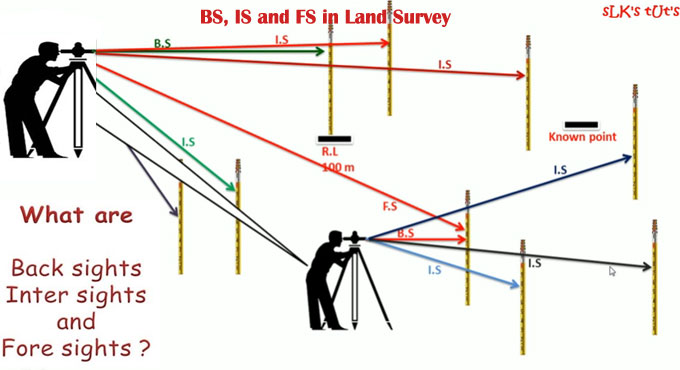
Significant Leveling Terms in Land Survey
In this article, You will find out about Leveling, Important terms in Leveling and Surveying. Along these lines, Let's Get Started.
What is Leveling in Surveying?
The specialty of determining the general heights of points on the surface of the earth is termed as "leveling." A leveling instrument called "Level" and "Staff" is utilized for this reason alongside different types of gear which are clarified in this article in subtleties.
The following are some of the most important information in land survey using levels. So don't miss any data and read everything.
Level Surface: This is a surface which is ordinary to the heading of gravity at all points as shown by a plumb line. The surface of a still lake might be taken for instance of a level surface. As the earth is an angled spheroid, a level surface won't be a plane however it will be a reviled one. Each point on a level surface is equidistant from the focal point of the earth.
Level Line: A line lying all through on a level surface is a level line. This is ordinary to the plumb line at all points.
Horizontal Plane: A horizontal plane through a point is a plane extraneous to the level surface at the point. This is typical to the heading of gravity by then.
Horizontal Line: Any line lying all through in a horizontal plane is termed as "horizontal line."
Vertical Plane: A vertical plane is any plane containing a vertical line. A vertical line anytime is a line typical to the level surface by then. A plumb line is a case of a vertical line.
Datum Surface: This is a self-assertive surface regarding which the elevations of points are estimated and analyzed.
Elevation of a Point: Elevation of a point is the vertical separation above or beneath the datum. This is normally called the decreased level (R.L) of the point. This might be certain or negative in like manner as the point is above or beneath the datum.
Line of Collimation: The line of collimation or the line of sight is the line joining the convergence of line of sight to the optical focus of the item glass and its continuation.
Axis of Telescope: The axis of a telescope is the line joining the optical focus of the item glass to the focal point of the eye piece.
Axis of Bubble Tube: The axis of the air pocket cylinder or level cylinder is the line distracting to the longitudinal bend of the air pocket tube at its center point. This is horizontal when the air pocket is focused. This is additionally called "bubble line."
Vertical Axis: The vertical axis is the line about which the telescope can be pivoted in a horizontal plane. Watch the Video Below for better understanding.
Back Sight: A back sight (B.S) is the principal staff perusing taken subsequent to setting up the instrument in any position. This will consistently be perusing on the point of known elevation.
Fore Sight: A fore sight (F.S) is the last staff perusing taken before moving the instrument. This will consistently be perusing a point whose elevation is to be determined. This perusing shows the moving of the instrument.
Intermediate Sight: An intermediate sight (I.S) is any staff perusing assumed the point of obscure elevation after the back sight and before the fore sight. This is important when in excess of two staff readings are taken from a similar situation of the instrument.
Change Point: A change point (C.P) shows the moving of the instrument. Both back sight and fore sight are taken on a change point.
Stature of the Instrument: The Height of instrument (H.I) is the elevation of the plane of collimation when the instrument is leveled (and not the tallness of the focal point of the telescope over the ground level).
Station Point: A station point is a point whose elevation is to be determined or a point which is to be set up at a known elevation. Therefore, this is the point on which the staff is held and not the point on which the instrument is set up.
Benchmark: A benchmark (B.M) is a fixed point of reference of known elevation. The diminished level of the benchmark is utilized to determine the decreased levels of different points. These might be grouped in Leveling and Surveying as:
1. G.T.S (extraordinary trigonometrical survey) benchmark
2. Perpetual benchmark
3. Self-assertive benchmark
4. Temporary benchmark
The G.T.S benchmarks are those set up by the Survey Departments of a nation. These have been set up at stretches everywhere throughout the nation with high exactness concerning the fundamental ocean level as the datum. Their elevations and diminished levels are appeared on GTS maps.
As the time periods G.T.S benchmark is enormous, to encourage the survey works, government organizations, for example, the P.W.D (Public Work Departments), and so on have set up benchmarks between these G.T.S benchmarks at closer spans.
The benchmark in the beneath picture is known as "Perpetual benchmarks." These are set apart on very much characterized and changeless points, for example, achievements, corners of plinths of structures, head of parapets of scaffolds, and so on.
In little surveying and leveling works, the decreased level of a very much characterized reference point is discretionarily expected. These are designated "subjective benchmarks." Transitory benchmarks are the reference points Which are set up when there is a break in the work. This becomes essential when the entire surveying and leveling work can't be finished at a stretch.
The survey work is shut on a perpetual point which can be handily found when the work is again continued and begun from a similar point. A debt of gratitude is in order for Reading this Article! Kindly, Don't Forget to share it.
To get more clear conception, go through the following video tutorial.
Video Source: Engineer Boy


